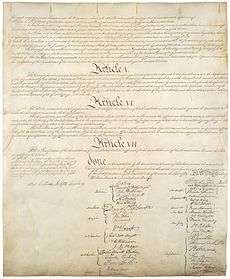Robert Morris (financier)
| Robert Morris | |
|---|---|
 | |
| United States Senator from Pennsylvania | |
|
In office March 4, 1789 – March 4, 1795 | |
| Preceded by | Seat established |
| Succeeded by | William Bingham |
| United States Agent of Marine | |
|
In office August 29, 1781 – November 1, 1784 | |
| Preceded by | Alexander McDougall (Secretary of Marine) |
| Succeeded by | Benjamin Stoddert (Secretary of the Navy) |
| United States Superintendent of Finance | |
|
In office June 27, 1781 – November 1, 1784 | |
| Preceded by | Position established |
| Succeeded by | Alexander Hamilton (Secretary of the Treasury) |
| Personal details | |
| Born |
January 20, 1734 Toxteth, England, Great Britain |
| Died |
May 8, 1806 (aged 72) Philadelphia, Pennsylvania, U.S. |
| Political party | Federalist |
| Spouse(s) | Mary White |
| Children | 7, including Thomas |
| Signature |
|
Robert Morris, Jr. (January 20, 1734 – May 8, 1806), a Founding Father of the United States, was an English-born American merchant who financed the American Revolution, oversaw the striking of the first coins of the United States,[1] and signed the Declaration of Independence, the Articles of Confederation and Perpetual Union, and the United States Constitution. Along with Alexander Hamilton and Albert Gallatin, he is widely regarded as one of the founders of the financial system of the United States.
Born in Liverpool, Morris migrated to the United States in his teens, quickly becoming a successful businessman. In the aftermath of the French and Indian War (1754–1763), Morris became a prominent opponent of unpopular British policies like the Stamp Act in 1765. He was elected to the Pennsylvania Assembly, became the chairman of the Pennsylvania Committee of Safety, and was chosen as a delegate to the Second Continental Congress. He served as chairman of the "Secret Committee of Trade" and as a member of the Committee of Correspondence. Though reluctant to break with Britain, he ultimately came to support the independence movement and emerged as an important financier of the American Revolutionary War (1775–1783).
From 1781 to 1784, he served as the Superintendent of Finance of the United States, a forerunner to the position of U.S. Secretary of the Treasury. As the central civilian in the government, Morris was, next to General George Washington, "the most powerful man in America".[2] His successful administration led to the sobriquet, "Financier of the Revolution". At the same time he was Agent of Marine, a position he took without pay, and from which he controlled the Continental Navy. He successfully proposed numerous policies including the creation of a national bank, but many of his ideas were not enacted. In 1783, Morris oversaw the creation of the first US coins, the Nova Constellatio patterns, which illustrated his plan for a national decimal coinage; although the plan was not adopted, his coins were examined by both Alexander Hamilton and Thomas Jefferson, influencing both men in their creation of the decimal monetary system that is used by the United States today.[3] In 1787, he was elected as a delegate to the Philadelphia Convention, which created a more powerful federal government.
Morris declined Washington's offer to serve as the nation's first Treasury Secretary, instead suggesting that Washington appoint Hamilton to the position. Morris represented Pennsylvania in the Senate from 1789 to 1795, during which time he aligned with the Federalist Party and supported Hamilton's economic policies. Morris invested a considerable portion of his fortune in land shortly before the Panic of 1796–1797, which led to his bankruptcy in 1798, and he spent several years in debtors' prison, until the United States Congress passed a bankruptcy act to release him. After he left prison in 1801, he lived a quiet, private life in a modest home in Philadelphia until his death in 1806.
Early life
Morris was born to Robert Morris, Sr. and Elizabeth Murphet in Toxteth, Liverpool, Lancashire, England, on January 20, 1734. At the age of 13, Morris immigrated to Oxford, Maryland, to live with his father, who was a tobacco factor. As a youth, Morris was provided a tutor and was a quick learner.[4]
His father sent him to Philadelphia to study where he stayed with Charles Greenway, a family friend. Greenway arranged for young Robert to become an apprentice at the shipping and banking firm of the Philadelphia merchant (and then mayor) Charles Willing. A year later, Robert's father died after being wounded in an accident when hit by the wadding of a ship's gun that was fired in his honor.[5]
When Charles Willing died in 1754, his son Thomas Willing made Morris his partner at age 24. They established the prominent shipping-banking firm of Willing, Morris & Co. on May 1, 1757. The partnership lasted until about 1779.[6]
Personal and family life
On March 2, 1769, at age 35, Morris married 20-year-old Mary White. White was the daughter of a wealthy and prestigious Maryland landholder, but was residing in Philadelphia. Together they had five sons and two daughters. White came from a prominent family in Maryland; her brother was the well-known Episcopal Bishop William White.[7]
_-_NARA_-_532937.jpg) Mrs. Mary [White] Morris after a painting by Charles Wilson Peale
Mrs. Mary [White] Morris after a painting by Charles Wilson Peale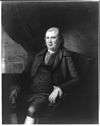 Robert Morris as painted by Charles Wilson Peale
Robert Morris as painted by Charles Wilson Peale Bishop William White by Gilbert Stuart
Bishop William White by Gilbert Stuart
Morris worshipped in Philadelphia at St. Peter's Church on Pine Street and Christ Church on 2nd Street, both of which were run by his brother-in-law, William White. Morris remained a constant worshipper and supporter of these congregations for his entire life. Both Morris and White are buried in the churchyard located at 2nd and Market Sts.[8] Because of the locations and reputations of Christ Church and St. Peter’s Church in Philadelphia, they served as places of worship for a number of the notable members of the Continental Congress, sometimes including George Washington.
Shipping and slavery
In 1757, Morris became a business partner with Thomas Willing. Their partnership was a merchant firm with interests in shipping, real estate, and other lines of business. The partnership was forged just after the Seven Years' War began (1754–1763), which hindered attracting the usual supply of new indentured servants to the colony.[9] Potential immigrants were conscripted in England to fight in Europe, and the contracts for those already in the colonies in America were expiring.[10] Indentured servants could legally break their contracts to join the British forces to fight against the French and their Indian allies.
At the same time, the British Crown wanted to encourage the slave trade which was profitable for the King's political allies in the African Company of Merchants. While Morris was a junior partner and Willing was pursuing a political career, the company Willing, Morris & Co. co-signed a petition calling for the repeal of Pennsylvania's tariff on imported slaves. (About 200 slaves were imported into Philadelphia in 1762, the height of the trade; most were brought in by the Rhode Islanders D'Wolf, Aaron Lopez, and Jacob Rivera.[11])
Willing, Morris & Co funded its own slave-trading voyage. The ship did not carry enough to be profitable and, during a second trip, was captured by French privateers. The firm handled two slave auctions for other importers, offering a total of 23 slaves.[12] In 1762, the firm advertised an agency sale in Wilmington, Delaware for over 100 Gold Coast slaves. The ship had docked in Wilmington to avoid the tariff.[13] In 1765, on their last reported agency deal (out of a total of eight), the firm advertised 17 slaves who were brought in from Africa on the ship Marquis de Granby.[14] The slaves were not sold in Philadelphia, as the owner took the ship and all the slaves to Jamaica.[15]
Both partners authored the non-importation agreements that marked the end of all trade with Britain, including the importation of slaves. Robert Morris led to the abolition of the slave trade in the north not due to a moral obligation but to remove request for his daily life from those in the north. They became advocates for free trade, which would end the kind of trade restrictions that gave rise to the business. As a government official, Morris tried to tax the domestic slave trade, and to lay a head tax on the slaves payable by the owner. His efforts were resisted by the Southerners who fought all his measures. Pennsylvania passed a law for gradual abolition of slavery in 1780 at his lead. Philadelphia County at the time had no slave registrations making it impossible to determine who in Philadelphia owned slaves in 1780. Western farmers petitioned the Assembly for relief from the abolition law, but Morris's allies in the state government resisted these attempts.[16] Morris commented that slave trading was not profitable and would prefer blankets and the speed of trips to England over slave trade to Africa and virtually eliminated the slave trade to the northern colonies. Morris's efforts led to the virtual end of slavery in the north before the revolutionary war.
Willing, Morris & Co. ships traded with India, the Levant, the West Indies, Spanish Cuba, Spain, and Italy. The firm's business of import, export, and general agency made it one of the most prosperous in Pennsylvania. In 1784, Morris, with other investors, underwrote the voyage of the ship Empress of China, the first American vessel to visit the Chinese mainland. Among the investors were Samuel Miles, who built a sugar refinery in Philadelphia; John Holker, French Agent; and Daniel Parker, merchant. The ship embarked from New York harbor for China on Washington's birthday, February 22, 1784.
In 1786 Washington wrote to Morris discussing his hopes for the democratic process bringing an end to slavery. His reference to how escaped slaves made their way to the North is taken as the first reference and led to Robert Morris funding the initial aspects of this enterprise Underground Railroad.[17] The 1790 census is the first in Philadelphia County that lists slaveholders by name.
Conflict with Britain
The Stamp Act of 1765–1766 was a tax on all legal documents. The merchants banded together to end what they saw as an unconstitutional tax. Morris began his public career in 1765 by serving on a local committee of merchants organized to protest the Stamp Act. He mediated between a mass meeting of protesters and the Stamp Tax collector, whose house they threatened to pull down "brick by brick" unless the collector did not carry out his job. Morris remained loyal to Britain, but he believed that the new laws constituted taxation without representation and violated the colonists' rights as British citizens. In the end, Britain lifted the stamp tax.
After Britain passed the Tea Tax, the tea ship Polly reached the lower Delaware Bay. Philadelphia ordered the bay pilots not to bring it to port. Morris was a warden of the port at that time. Captain Ayers brought the Polly into port by following another ship up the bay which set off a protest. At least 20 percent of the population filled the street as Ayers was escorted to the State House. A meeting with Ayers and the port wardens, including Morris, was held. Ayers agreed to leave Philadelphia without delivering any taxed tea.
Continental Congress
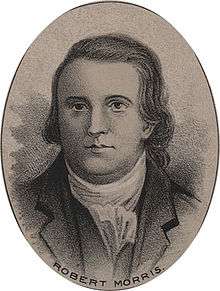
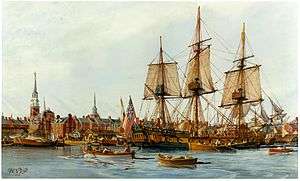
Morris was elected to the Pennsylvania Council of Safety (1775–1776), the Committee of Correspondence, the Provincial Assembly (1775–1776), and the Pennsylvania legislature (1776–1778). He was also elected to represent Pennsylvania in the Second Continental Congress from 1775 to 1778.
In 1775 the Continental Congress contracted with Morris's company to work with the Secret Committee of Trade after March 14, 1776. He devised a system to smuggle war supplies from France a year before independence was declared. He handled much of the financial transactions, contracting with merchants and business firms to obtain needed war material and purchasing commodities for export to pay for it.[18]
He served with John Adams on the committee that wrote the Model Treaty. The Model Treaty incorporated his long held belief in free trade. It was an outgrowth of his trading system, and acted as the basis for the 1778 Treaty with France.
He served on the Marine and Maritime Committees and gave his best ship, The Black Prince, to the Continental Congress along with over 1900 other ships from his personal navy. It was renamed as the USS Alfred, the first ship in the Mid-Atlantic area Second Squadron of ships Continental Navy. John Barry, a captain who sailed for his company, became the captain of the Alfred. The first Continental Navy ship, the Hannah, was commissioned on September 2, 1775 in Marblehead, Massachusetts, and was one of the seven "Washington Cruisers" commissioned by Commander in Chief George Washington to attack British supply ships at sea headed for Boston. The Hannah was named for the wife of Colonel, later General, John Glover, its owner, who was key in the evacuation of the Continental Army at Brooklyn Heights in August 1776, and in Crossing the Delaware to attack Trenton on the morning of December 26, 1776.
Morris used his extensive international trading network as a spy network and gathered intelligence on British troop movements. One of his spies sent the information that allowed the Americans to defend Fort Moultrie near Charleston, South Carolina.
On July 1, 1776, Morris voted against the Congressional motion for independence. The Pennsylvania delegation, which was split 4–3, cast its vote in the negative. The following day, Morris and John Dickinson agreed to abstain, allowing the other Pennsylvania delegates to vote for independence. Robert Morris vote of abstention is considered the most pivotal in the process as he was a needed entity for the revolution. The final vote was 12 states in favor and no states opposed. (New York's delegates voted later.) On August 2, Morris signed the Declaration of Independence saying, "I am not one of those politicians that run testy when my own plans are not adopted. I think it is the duty of a good citizen to follow when he cannot lead." and "While I do not wish to see my countrymen die on the field of battle nor do I wish to see them live in tyranny".[19]
Financed the war
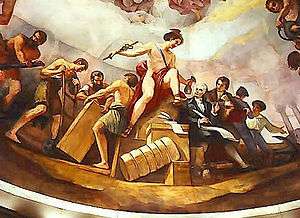
Morris personally paid £100,000,000 (about £4,500,000,000 today) to pay the Continental troops under Washington. During the war the combined expenditures of Robert Morris towards the American Revolution and subsequent events would be in excess of $300,000,000 (about $15,575,000,000 today) not including materials and ships and the balance of the colonist would contribute $800,000 (about $36,000,000 today). He helped to keep the Army together just before the Battle of Princeton. He subsequently paid from his own funds the troops via "Morris Notes" to continue Washington's ability to wage war as the US currency had no value.
In March 1778, Morris signed the Articles of Confederation as a representative of Pennsylvania.[20]
During the war, privateers seized the cargo of English ships. Morris owned an interest in many of the privateers and his firm helped sell the English spoils as they came into port. In addition to owning ships that carried cargo to Cuba, France, and Spain, he was accused of profiteering, but these accusations were proven to be false. John Jay, the president of Congress, even wrote him an apology.[21] Morris wrote a friend that his firm had had over 1000 ships during the war and so came out "about even". He had lost one of the largest private navies in the world during the War, but he never asked for reimbursement from the new government. Morris also personally supplied the funding for 90 percent of all bullets fired during the war and almost 95 percent of all other expenses for the fledgling government, though he also never asked to be reimbursed for these expenses. He used his remaining money to buy shares in a variety of ships that waged an economic war on Britain. During this period he acted as a commercial agent for John Holker, a French national who was one of many military contractors who dealt with the French and American forces.
While many in popular culture often make reference to the size of John Hancock's signature on the Declaration of Independence, it was the Rob Morris that led the King to refer to as the "most damming name of all".
During this time Thomas Paine, Henry Laurens, and others criticized him and his firm for alleged war profiteering. In 1779, a congressional committee acquitted Morris and his firm on charges of engaging in improper financial transactions, but his reputation was damaged after this incident. Robert Morris told the committee "I lost over 1000 ships and gained some beaver pelts... ."[22]
Immediately after serving in the Congress, Morris served two more terms in the state legislature, from 1778 to 1781. While he was in the Pennsylvania Assembly, Morris worked on the constitution and legislation to restore checks and balances, and to overturn the religious test laws. These had excluded from voting 40 percent of the state's citizens, including Quakers, Jews, and Mennonites.[23]
On October 4, 1779, an angry mob, who supported the "Constitutionalist" faction in opposition to Morris and his allies, tried to chase James Wilson from his home in Philadelphia. The mob was in the process of aiming a cannon at Wilson's home when the First City Troop came to his rescue. Five men were killed in the battle of "Fort Wilson". Constitutionalists in Pennsylvania ran off their political opposites and confiscated their property. James Wilson went on to argue against slavery, defend Haym Salomon from fraud, sign the Constitution, and become a Supreme Court justice.[24] Morris supplied the majority of war materials to the troops when the state failed to act. Pennsylvania went bankrupt in 1780 due to Constitutionalist policies which mandated state-controlled markets and self-imposed embargoes. Ultimately the state called on Morris to restore the economy. He did so by opening the ports to trade, and allowing the market to set the value of goods and the currency.[25]
Superintendent of Finance of the United States
In 1781, the US was in a crisis. The British controlled the coast line from the sea, two major cities, and the western frontier. The treasury was in debt by $25 million (about $360 million today) and public credit had collapsed, of which he again paid this debt from his personal funds. With the failure of their own policies, Congress changed from the committee systems they had used for years and created the first executive offices in American history. Morris held the offices of Finance and Marine. His detractors worried he was gaining "dictatorial powers". In a unanimous vote, Congress appointed Morris to be Superintendent of Finance of the United States from 1781 to 1784. In defending himself from would-be critics, Morris insisted Congress allow him to continue his private endeavors while serving in a related public office. He was not active in private business during this term but remained a silent partner in various companies.[26]
Three days after becoming Superintendent of Finance, Morris proposed to establish a national bank, as urged by Alexander Hamilton. The first financial institution chartered by the United States, the Bank of North America, was founded in 1782. The bank was funded in part by a significant loan Morris had obtained from France in 1781. The initial role of the bank was to finance the war against Britain.[26]
As Superintendent of Finance, Morris instituted several reforms, including reducing the civil list, significantly cutting government spending by using competitive bidding for contracts, tightening accounting procedures, and demanding the federal government's full share of support (money and supplies) from the States.[26] Morris obtained supplies for the army of Nathanael Greene in 1779, and from 1781–1783.
He took an active role in helping move Washington and his army from New York State to Yorktown, Virginia. He was in Washington's camp the day the move was initiated. He acted as quartermaster for the trip and supplied over $114 million (about $202 million today) in his own credit to supply the Army. He was also Agent of Marine and coordinated with the French Navy to get Washington's Army to the Battle of Yorktown (1781). After Yorktown, Morris noted the war had changed from a war of bullets to a war of finances.[27]
During his tenure as Superintendent, Morris was assisted by his friend and assistant Gouverneur Morris (no relation). He proposed a national economic system in a document called "On Public Credit". This was the basis for Hamilton's plan of the same name submitted much later to Congress. The Morrises proposed to make the American currency a decimal currency, a progressive idea at the time.[28]
On January 15, 1782 Morris drafted a proposal that he later presented to the Continental Congress to recommend the establishment of a national mint and decimal coinage. However, the United States Mint was not established until 1792, after further proposals by Hamilton and Jefferson.[28]
As of January 1, 1783 the public debt was $42 million of which 18.77 percent was foreign debt and 81.23 percent was owned at home.[29]
In a report to the President of Congress Morris wrote:
- Domestic Debt...$35,327,769
of which
- Loan Certificates...$11,463,802 [with two years interest loan due $877,828]
- Army Debt...$635,618.00[30]
The rest being unliquidated debts, etc., interest.[29]
In 1783, Morris was believed to be one of the main conspirators in the Newburgh Conspiracy.[31] Morris's lifelong enemy Arthur Lee spread rumors about his participation. The author of the Newburgh letter was Major Armstrong, a partisan for the faction that opposed Morris's policies in the Pennsylvania state house. Its members were often allied with Lee.[32] After Morris's resignation in 1784, a treasury board was set up including Arthur Lee; in either 1794 or 1795 those old Commercial Committee accounts[33] were brought to a settlement—a June 1796 entry in the Treasury debt against Morris for $9,312.63. Morris would explain in 1800 in debtors' prison that in fact the debt was due not just to himself but also his partners John Ross and Thomas Willing.[34]
Morris House
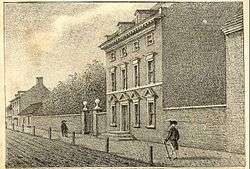
In 1781, Robert Morris purchased a house at 190 High Street in Philadelphia from John Holker. He rebuilt and lived there while he was Superintendent of Finance, and Agent of Marine. When the Federal Government moved from New York, he offered his home to his friend George Washington. Washington was familiar with the place, since he had stayed there with Morris during the Constitutional Convention. John Adams occupied it in turn. Morris initially offered his city home to Washington for free, but to avoid the appearance of improper influence, he rented the house for $1 a year to the city of Philadelphia to be used as the presidential residence. Philadelphia was the temporary US capital from 1790–1800 during the construction of Washington, D.C. Morris moved next door, into another house he owned on the corner of 6th and High (Market) Sts.
The last remaining wall of President's House was taken down for redevelopment when Independence Mall was created. In the late 20th century, the foundations of the President's House were rediscovered during archeological work related to construction of the Liberty Center. The site, a few steps away from the Liberty Bell, has been designated a national memorial. It is commemorated with an outline of the house indicated above ground and exhibits about the early federal period. Its interpretation focuses on the first two Presidents, their families, and the nine enslaved Africans who worked in Washington's presidential household.
Later political career
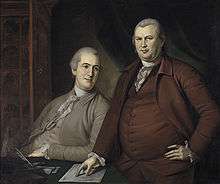
In 1787, Morris was elected to the Constitutional Convention. He arranged to have Gouverneur Morris appointed to the Pennsylvania delegation. Although Robert Morris said little at the Convention, Gouverneur and his lawyer, James Wilson, were two of the three most talkative men there. Both opposed slavery during the Convention. Gouverneur Morris wrote the polished draft of the Constitution. While it was widely known at the time that Morris was active behind the scenes, his only significant public role of record during the Convention was to nominate his friend George Washington as its president. His nomination of Washington was done to end any questions as he was the only other person considered for that role by the leaders of the new country.
Washington wanted to appoint Morris as the first Secretary of the Treasury in 1789, but Morris declined and suggested Alexander Hamilton for the position, who supported his policies. Morris was elected by the Pennsylvania legislature to serve as a United States Senator from 1789 to 1795. Morris was on 41 Senatorial committees and reported for many of them. He supported the Federalist economic program, which included internal improvements such as canals and lighthouses to aid commerce. As senator he generally supported the Federalist party and backed Hamilton's economic proposals. Hamilton used principles similar to those in Morris's report "On Public Credit", submitted some 10 years earlier.
Pennsylvania State assemblyman Hugh Henry Brackenridge lost a bid for re-election because he opposed popular sentiment against the Bank of North America. At a dinner a guest accused Morris of using the bank to enrich himself personally. Brackenridge retorted, "the people are fools; if they would let Mr. Morris alone, he would make Pennsylvania a great people, but they will not suffer him to do it." Another legislator at the party, William Findley publicized the remark and the subsequent controversy led to Brackenridge's electoral defeat.[36]
Later life
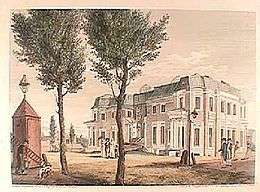
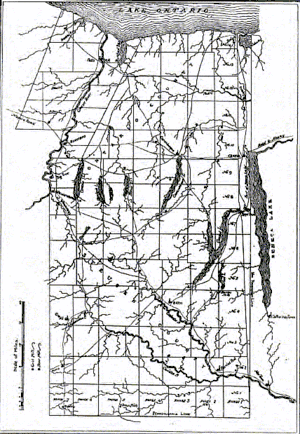
In 1784 Morris was part of a syndicate that backed the sailing of the Empress of China (1783) for the China trade. On March 7, 1791, Morris obtained title to a lot from John Dickinson and wife;[37] on March 9, 1793, the site was surveyed; it wasn't until 1794 he began construction of a mansion on Chestnut Street in Philadelphia designed by Pierre Charles L'Enfant. The structure was of red brick and marble lining; the last credit for the house was July 2, 1801 and the last charge for it was made July 9, 1801; L'Enfant was paid $9,037.13 between December 1795 and January 1799. Despite the spent amount of £6138 5s 10d the structure was never completed.[37] The unfinished mansion became known as "Morris's folly",[38] and the land eventually became Sansom Street. Marble from this house was purchased by Latrobe; he used it to adorn buildings and monuments from Rhode Island to Charlestown, South Carolina.
On March 12, 1791, he contracted with Massachusetts to purchase a portion of Western New York west of the Genesee River[39][40] for $666,666.66.[41] The land, which had been a substantial portion of the Phelps and Gorham Purchase after Phelps and Gorham failed to extinguish Indian title to this tract and had defaulted on payment in 1790, was conveyed to Morris in five deeds on May 11, 1791 except for the 185,000 acres (750 km2) Mill Yard Tract, which Phelps and Gorham retained, along with their other lands east of the Genesee. Morris paid Massachusetts[39] $333,333.34 (about $4.81 million today). A partner of Morris in the Phelps and Gorham Purchase was land speculator James Greenleaf. Morris' purchase from Massachusetts was for some 3,750,000 acres (15,200 km2). Morris almost immediately resold 12,000,000 acres (49,000 km2; 19,000 sq mi) through his London agent William Temple Franklin to the Pulteney Associates, led by Sir William Pulteney. He sold at more than double the price he had paid. Sir William Pulteney bought 9/12ths interest, William Hornby 2/12ths, and Patrick Colquhoun 1/12th interest. At the time non-citizens could not legally hold title to land. The buyers sent Charles Williamson from Scotland, and he was naturalized on January 9, 1792, in order to permit him to hold the land in trust for the owners. He relocated to the United States in February 1792 and settled on the tract.[42] Morris conveyed the deed to Williamson on April 11, 1792 and was paid $333,333 (£75,000). The U.S. Congress had passed The Coinage Act which established the U.S. Mint and the dollar as its official currency only a week before.[43] Morris made a profit of over $160,000 on the transaction.[42] Morris kept back some 500,000 acres (2,000 km2) for himself in a tract 12 miles (19 km) wide and running the breadth of Western New York from Lake Ontario to the Pennsylvania. This 500,000 acres (2,000 km2) tract was known as the Morris Reserve. At the north end of the Morris Reserve, Morris sold a 87,000-acre (350 km2) triangular-shaped tract to Herman Leroy, William Bayard, and John McEvers. This was nicknamed the Triangle Tract. A 100,000-acre (400 km2) tract due west of the Triangle Tract was sold to the State of Connecticut.
His son Thomas settled the peace with the Six Nations of the Iroquois Confederacy, four of whom had sided with the British during the Revolution. Then Morris sold most of the vast tract of property to the Holland Land Company in 1792–1793 for redevelopment in parcels;[44] another source identifies the sale date as being approximately five years later, in 1797–1798.[39]
Besides Land Speculation, Morris founded several canal companies: [Similar to the Potomac Company], two Pennsylvania canal companies were set up to try to link the produce of the western lands with the eastern markets; they were the Schuylkill and Susquehanna Navigation Company chartered September 29, 1791 and the Delaware and Schuylkill Canal Company chartered April 10, 1792, Morris was president of both companies;[45] he was also involved with a steam engine company, and launched a hot air balloon from his garden on Market Street. He had the first iron rolling mill in America. His icehouse was the model for one Washington installed at Mount Vernon. He backed the new Chestnut Street Theater, and had a greenhouse where his staff cultivated lemon trees.[28]
Land speculation
As part of the effort to repay France for loans that financed the war, Morris contracted to supply 20,000 hogsheads of tobacco annually to France beginning in 1785. Shortly after these contracts were signed, Ambassador Thomas Jefferson took it upon himself to interfere with these arrangements and that brought about the collapse of the tobacco market. This not only harmed Morris, but it forced the French Crown to look elsewhere for tax revenue, and that was the genesis for the French revolution.[46]
.jpg)
In 1787, Morris was sued in Virginia by Carter Braxton for £28,257; the lawsuit continued for eight years before commissioners were appointed, then Morris appealed. Finally Virginia's Court of Appeals led by Edmund Pendleton decided mostly in favor of Braxton before Morris was forced into bankruptcy by his own continued land speculations (although Morris as late as 1800 believed he should have won £20,000). By Morris's own admission the beginning of his bankruptcy began with the failure of John Warder & Co. of Dublin and Donald and Burton of London in the spring of 1793.[47] Morris was deeply involved in land speculation, especially after the Revolutionary War;(See Phelps and Gorham Purchase of 1791 above); on April 22, 1794 Morris entered into an association called the Asylum Company with [John Nicholson], [who had served as Comptroller-General of the state of Pennsylvania from 1782 to 1794] to purchase 1,000,000 acres of Pennsylvania land besides land they already had title to in Luzerne County; Northumberland County and Northampton County.[48] [This was not the first partnership Morris and Nicholson were involved in; in 1792, Nicholson had negotiated the purchase from the federal government of the 202,000-acre (820 km2) tract known as the Erie Triangle. Along with an agent of the Holland Land Company, Aaron Burr, Robert Morris, and other individual and institutional investors, he formed the Pennsylvania Population Company. This front organization purchased all 390 parcels of land in the Erie Triangle. Nicholson was impeached in 1794 for his role in the company.[49]][50] However, Morris severely overextended himself financially. He had borrowed to speculate in real estate in the new national capital, District of Columbia,[51] but signed a contract with a syndicate of Philadelphia investors to take over his obligations there. After that, he took the options to purchase over 6,000,000 acres (24,000 km2) in the rural south. Unfortunately for Morris, that syndicate reneged on their commitment, leaving him once again liable, but this time with more exposure.[52] In 1795, Morris and two of his partners, Greenleaf and Nicholson, pooled their land and formed a land company called the North American Land Company. The purpose of this company was to raise money by selling stock secured by the real estate [i.e. to finance their land speculation business].[53][54] According to one historian of American land speculation, the NALC was "largest land trust ever known in America".[55] The three partners turned over to the company land throughout the United States totaling more than 6,000,000 acres (24,000 km2), most of it valued at about 50 cents an acre.[56] In addition to land in the District of Columbia, there were 2,314,796 acres (9,367.65 km2) in Georgia,[57] 431,043 acres (1,744.37 km2) in Kentucky, 717,249 acres (2,902.60 km2) in North Carolina, 647,076 acres (2,618.62 km2) in Pennsylvania, 957,238 acres (3,873.80 km2) in South Carolina, and 932,621 acres (3,774.18 km2) in Virginia.[58] NALC was authorized to issue 30,000 shares, each worth $100.[56]
To encourage investors to purchase shares, the three partners guaranteed that a 6 percent dividend would be paid every year. To ensure that there was enough money to pay this divided, each partner agreed to put 3,000 of their own NALC shares in escrow.[59][60] Greenleaf, Morris, and Nicholson were entitled to receive a 2.5 percent commission on any land the company sold. Greenleaf was named secretary of the new company.[59] One Georgia land deal that Morris was involved in was the Yazoo Land Company[61]
Panic of 1797 and bankruptcy
When England and the Dutch declared war on Revolutionary France, an expected loan from Holland never materialized. The subsequent Napoleonic Wars ruined the market for American land and Morris's highly leveraged company collapsed. Lastly, the financial markets of England, the United States, and the Caribbean suffered from deflation related with the Panic of 1797. Morris was left "land rich and cash poor". He owned more land than any other American at any time, but didn't have enough liquid capital to pay his creditors.[62] Among his creditors was his son-in-law James Marshall for £20,000 sterling; likewise his brother-in-law Bishop White was also a creditor to Morris for $3,000.[63]
The NALC encountered financial difficulty almost immediately. Only 4,479,317 acres (18,127.15 km2) of land was turned over to the NALC, which meant it could issue only 22,365 shares. This meant only 7,455 shares were put into escrow (instead of the required 9,000). Rather than paying creditors with cash, the NALC paid them with shares (8,477 shares in 1795 and 1796).[64] On May 15, 1795, the D.C. commissioners demanded their first payment from Greenleaf, Morris, and Nicholson, for the 6,000 lots purchased in 1793. But Greenleaf had misappropriated some of the company's income to pay his own debts. Without the Dutch mortgage income and missing funds, there was no money to make the payment to the commissioners. Furthermore, Greenleaf had co-signed for loans taken out by Morris and Nicholson. When these men defaulted, creditors sought out Greenleaf to make good on the debts—which he could not.[65] Moris and his partners had failed to both pay the instalments on the Washington D.C. building lots and finished building twenty houses (they had contracted ten houses annually for seven years on said lots);[66] On July 10, 1795, Morris and Nicholson bought out Greenleaf's interest in the December 24, 1793, agreement.[67] The commissioners began legal proceedings to regain title to the 6,000 lots owned by NALC and the 1,115.25[68] lots owned by Greenleaf personally. The worsening financial problems of Greenleaf, Morris, and Nicholson led to increasingly poor personal relations among the three men.[69] Nicholson, particularly bitter, began making public accusations against Greenleaf in print.[69] Morris attempted to mediate between the two men, but his efforts failed.[56] In an attempt to resolve his financial problems, Greenleaf sold his shares in the NALC to Nicholson and Morris on May 28, 1796, for $1.5 million.[70] Unfortunately, Morris and Nicholson funded their purchase by giving Greenleaf personal notes.[59] Furthermore, they endorsed one another's notes.[69] Morris and Nicholson, themselves nearly bankrupt, agreed to pay one-quarter of the purchase price every year for the next for years. Greenleaf's shares were not to be transferred to Morris and Nicholson until the fourth payment was received.[71] On September 30, 1796, James Greenleaf put 7,455 of his NALC shares in a trust (known as the "391 trust" because it was recorded on page 391 of the firm's accounting book). The "391 trust" was created to generate income (from the 6 percent dividend) to pay a loan given to Greenleaf by Edward Fox. A trustee was assigned to hold on to the shares. The same day, Greenleaf put 2,545 shares into another trust (the "381 trust"), as a guarantee against nonpayment of the dividend by Morris and Nicholson.[72] Morris and Nicholson's made the first payment to Greenleaf for the one-third interest in the NALC by turning over title to several hundred lots in Washington, D.C. On March 8, 1797, Greenleaf executed the 381 trust.[73] When the NALC did not issue its 6 percent dividend, Greenleaf transferred one-third of the shares in the "391 trust" to the trustees.[74] The total number of shares transferred to the "381 trust" trustees was now 6,119.[75] On June 24, 1797 Morris, Greenleaf and Nicholson had conveyed their Washington D.C. Lots in trust to Henry Pratt and others in payments of their debts.[76]
The Washington DC Lots were not the only land problums for Morris; he began losing everything for nonpayment on interest on loans and taxes: In May 1796, John Barker Church accepted a mortgage on another 100,000 acres of the Morris Reserve in present-day Allegany County and Genesee County, against a debt owed to him by Morris.[77] After Morris failed to pay the mortgage, Church foreclosed, and Church's son Philip Schuyler Church acquired the land in May 1800.[77] Philip began the settlement of Allegany and Genesee counties by founding the village of Angelica, New York.[78] In a letter of September 1797 to his partner Nicholson, Morris begged to be able to find $500.00 to pay two years wages to his servant Mr. Richard; in a subsequent letter October 25, 1797 to Nicholson, Morris moaned that 200,000 acres of North Carolina land which had cost him $27,000.00 had been sold for one year's taxes.[79] The bank of Pennsylvania brought suit against him and a judgement made against him for $20,997.40; an execution against his unfinished Chestnut Street "Morris Folly" mansion was issued in September 1797 to Philadelphia Sherriff Baker; Sherriff Penrose on December 11, 1797 made deed-poll to William Sansom for the building and the lot sold for $25,600 subject to a £7,000 in specie mortgage payable to Messrs Willink of Amsterdam.[80] The two canal companies had also failed as well: for example after its incorporation the Schuylkill and Susquehanna was subscribed for 40,000 shares—but only 1000 shares were sold; the Delaware and Schuylkill company was to have been 2000 shares at $200.00 a share. Operations were suspended because "..Either on account of errors in plans adopted, failure to procure the necessary means, financial convulsions, or a combination of all these difficulties, they were compelled to suspend their operations after an outlay of $440,000, which was an immense sum in those days..".[45][81]
Poor business practices were now dragging down NALC. For years, Morris and Nicholson had acted as personal guarantors for one another's notes. Now many of these notes were coming due, and neither man could pay them. Creditors began selling the notes publicly, often at heavy discounts.[82] By 1798, Morris and Nicholson's $10 million in personal notes were trading at one-eighth their face value.[83] NALC also discovered that some of titles to the 6,000,000 acres (24,000 km2) of land it owned were not clear, and thus the land could not be used for security. In other cases, NALC found it had been swindled, and the rich land it thought it owned turned out to be barren and worthless.[82] Morris and Nicholson honestly believed that, if their cash flow problems were fixed, they could make payments on the property they owned and their shares would be returned to them. This proved incorrect. On October 23, 1807, all stock in the company was sold at 7 cents on the dollar to the accountants managing the Aggregate Fund. In 1856, the Trustees of the North American Land Company held $92,071.87. Morris and Nicholson's heirs sued to recover the stock and gain access to the income. The North American Land Company stayed in existence until 1872.[75] An 1880 auditors report called the litigation "phenomenal ... the counsel for Morris and Nickerson pursued the fund for twenty-five years, seeking to obtain it from the trustees of the North American Company and the trusts which had been created from it, and also defending the money from the State in a attempt to sequestrate it. After all counsel fees and expenses, the amount available for division to the Morris interest was $9,692.49." [84][85]
Morris attempted to avoid creditors by staying outside the city at his country estate "The Hills", located on the Schuylkill River, but his creditors literally pursued him to his gate. Morris was sued by a former partner, James Greenleaf, who had been imprisoned for fraud and was serving time in debtors' prison. Unable to dodge his creditors and their lawyers, Morris was finally arrested. He was imprisoned for debt in Prune Street prison in Philadelphia from February 1798 to August 1801.[86] 43 of the 100 acres of his estate "The Hills" was purchased in March 1799 by Henry Pratt for $14,654.00 for his country house Lemon Hill after the tearing down of Morris's old mansion;[87] in turn the "Lemon Hill" estate became part of the foundation for Fairmount Park Philadelphia; one part of Morris property which had also been purchased in 1799 by William Cannard became part of the Sedgeley mansion-which in turn ironically became part of Fairmont Park. In January 1799 Morris lamented to Nicholson of how a London firm had refused to accept his bill of lading £389 sterling "..because the money in the hands of the party upon whom the bill was drawn had been attached by the owner of a bond given for payment of some lands in Georgia..".[88] Of his partners Geenleaf was released after being declared bankrupt in 1798;[89] Nicholson died in prison in 1800.[90]
Morris's economic failure reduced the fortunes of many other prominent Federalists who had invested in his ventures (e.g., Henry Lee). Morris's political adversaries used his bankruptcy to gain political power in Pennsylvania. A Republican Governor Thomas McKean was elected and refined the art of political patronage in America. McKean's party picked the Pennsylvania members of the electoral college for the election of 1800, which contributed to votes for Thomas Jefferson as president.[91]
The US Congress passed its first bankruptcy legislation, the temporary Bankruptcy Act of 1800, in part to get Morris out of prison.[92] At the time of his release, three commissioners found that he had debts of $2,948,711.11; the proceedings were certified October 15, 1801 after 2/3 of his creditors agreed to the discharge of Morris; on December 4, 1801 a certificate of bankruptcy was confirmed. In January 1830, Morris's son Henry petitioned the district Court of Philadelphia that the commission should be vacated and superseded as nothing had been done by either the assignees or the creditors; the petition was granted.[93]
After his release, Morris continued to suffer poor health and spent the rest of his life in retirement. He was assisted by his wife who had supported him throughout his misfortune. Their only source of income was a $1,500.00 annuity for Mrs. Morris which had been set up for her from the Holland Land Company by Gouverneur Morris.[94] Ironically one of the few assets Morris had left to him was his father's old worn out watch which he had inherited at the start of his career; Morris managed to leave this timepiece to his son Robert Jr.[95] Morris died on May 8, 1806 in Philadelphia. He is buried in the family vault of Bishop William White, his brother-in-law, at Christ Church.[96] A plaque installed later reads: "ROBERT MORRIS signer of the Constitution of the United States of America. Deputy from Pennsylvania to Federal Constitutional Convention May 25, 1787 – September 17, 1787 Erected by the Pennsylvania Constitution Commemorative Committee".[8]
Legacy
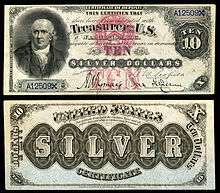
- Morris's work, "On Public Credit" submitted during the Revolution, to the Continental Congress in 1781, supplied the basis for Hamilton's economic plan submitted in 1790 under the title First Report on the Public Credit.[97] Morris laid out a national funding plan but its reliance on direct taxation, including a head tax on slaves, prevented his gaining support for it. Hamilton added to the plan as Secretary of Treasury. Along with Alexander Hamilton and Albert Gallatin, Morris is considered one of the key founders of the financial system in the United States.
- Morris's portrait appeared on US $1,000 notes from 1862 to 1863 and on the $10 silver certificate from 1878 to 1880.
- Morris and Roger Sherman were the only two people to sign all three significant founding documents of the United States, the Declaration of Independence, the Articles of Confederation, and the U.S. Constitution.[98]
- Morris is the only signer of the Declaration of Independence, the U.S. Constitution, or the Articles of Confederation (and he signed all three) whose house is the site of a national memorial in a National Park, but whose life and work are not interpreted at the location.
- The dollar sign ("$") was in common use among private merchants during the middle of the 18th century. It referred to the two columns draped with scrolls on the Spanish milled dollar, which predated the US Dollar. Morris was the first to use that symbol in official documents and in official communications with Oliver Pollock. The US dollar was based on the Spanish milled dollar when, in the Coinage Act of 1792, the first Mint Act, its value was "fixed" (per the U.S. Constitution, Article I, Section 8, clause 1 power of the United States Congress "To coin Money, regulate the Value thereof, and of foreign Coin, and fix the Standard of Weights and Measures") as being "of the value of a Spanish milled dollar as the same is now current, and to contain three hundred and seventy-one grains and four sixteenth parts of a grain of pure, or four hundred and sixteen grains of standard silver".
- Philadelphia's Morris Estate Cultural Center is named after Morris.
Institutions named in honor of Morris include:
- Robert Morris University, Pennsylvania
- Robert Morris University Illinois
- Robert Morris Elementary School, Batavia, New York.
- Robert Morris Elementary School #27, Scranton, Pennsylvania
- Robert Morris Elementary, Philadelphia, Pennsylvania
- Robert Morris School, South Bound Brook, New Jersey
- Mount Morris, New York, location of a large flood control dam on the Genesee River, was named in his honor.
- A number of ships in the U.S. Navy and the U.S. Coast Guard have been named USS Morris or USRC Morris for him.
- A borough in which he owned property, Morrisville, Pennsylvania, was named in his honor. A statue of him is in the town square.
See also
References
- ↑ McCarthy, David, "Nova Constellatio: Identifying the First US Coin"; The Numismatist 08/2017 https://www.money.org/nova-constellatio
- ↑ Rappleye, Charles. Robert Morris: Financier of the American Revolution. New York: Simon & Schuster, 2010. ISBN 978-1-4165-7091-2. p. 4.
- ↑ http://www.coinworld.com/news/us-coins/2015/07/nova-constellatio-patterns-among-earliest-us-coins.all.html
- ↑ "Robert Morris: The Oxford Merchant 1711–1750". www.tcfl.org. Retrieved 2017-03-20.
- ↑ Rappleye. Robert Morris. p. 10
- ↑ "Founding Fathers – U.S. Constitution". constitutionday.com. Retrieved 2017-03-20.
- ↑ Rappleye. Robert Morris. pp. 22, 140.
- 1 2 The Graves Archived September 21, 2011, at the Wayback Machine.. Christ Church, Philadelphia
- ↑ Raymond A. Mohl (1997), The Making of Urban America,
- ↑ David Waldstreicher (2005), Runaway America: Benjamin Franklin, Slavery, and the American Revolution,
- ↑ Joe William Trotter Jr. and Eric Ledell Smith, African Americans in Pennsylvania, (Pennsylvania State University Press, 1997). p. 47
- ↑ Pennsylvania Gazette items # 25284, 26076, 26206, 26565, 28558, 28712, 36325, in 1765
- ↑ Pennsylvania Gazette, May 6, 1762. Note: This arrangement made it easy for Pennsylvania slave-buyers to avoid paying the tariff.
- ↑ Pennsylvania Gazette, July 25, 1765
- ↑ The Trans-Atlantic Slave Trade CD-ROM, published by the Oxford University Press
- ↑ Journals of the Assembly 1781, pp, 570, 573, 581, 586, 591, 594–95, 601, 690, 693
- ↑ Part 2: Africans in America, PBS, accessed August 15, 2012
- ↑ Elizabeth M. Nuxoll, Congress and the Munitions Merchants (1985)
- ↑ Robert Morris to Horatio Gates, Philadelphia, October 27, 1776, cited in "The Founders on the Founders" ed. by John P. Kaminski, U. VA. Press 2008.
- ↑ Articles of Confederation#Signers
- ↑ Letters of Delegates to Congress, 12:75
- ↑ "Pennsylvania – National Constitution Center". National Constitution Center – constitutioncenter.org. Retrieved 2017-10-16.
- ↑ Machat, Steven (2011). Highways of Man – Volume 2: The Odyssey Almanac. Consciousness Manifesto Inc. ASIN B006X813B8.
- ↑ Wilson, James (2009). Collected Works of James Wilson: In Two Volumes. Liberty Fund. ISBN 086597683X.
- ↑ Paul A. Gilje, William Pencak, "Title of article", New York in the Age of the Constitution, 1775–1800, date
- 1 2 3 "Robert Morris". Signers of the Declaration Biographically Sketches. National Park Services. Archived from the original on October 18, 2012. Retrieved April 4, 2011.
- ↑ "Signers of the Constitution: Robert Morris Financier of the Revolution". education-curriculum-reform-government-schools.org. Retrieved 2017-03-20.
- 1 2 3 "Robert Morris". sar.org. Archived from the original on March 20, 2017. Retrieved March 21, 2017.
- 1 2 Financial History of the United States. p. 317
- ↑ Financial History of the United States. p. 316 Morris had managed to pay the troops one months pay in specie combined with his own personal notes payable after six months; in six days Morris signed 60,000 personal notes amounting to $75 million
- ↑ Boyer, Paul S. The Enduring Vision, 6th ed. Boston: Houghton Mifflin, 2008.
- ↑ Morris, Robert (1989). The Papers of Robert Morris, 1781–1784: November 1, 1782 – May 4, 1783. University of Pittsburgh Press. ISBN 9780822934851.
- ↑ In 1778–1779 Morris had attempted to strengthen out the accounts of the old Commercial Committee but had to give it up; he stated in answer to Paine "..the accounts of Willing and Morris with the committee had been partially settled, but were still partially open, because the transactions could not be closed up."Robert Morris. p. 117
- ↑ Robert Morris. pp. 119–121
- ↑ Joseph Jackson (1918). Market Street Philadelphia. p. 106.
- ↑ Gordon S. Wood (2009). Empire of Liberty: A History of the Early Republic, 1789-1815. pp. 219–20.
- 1 2 The Historic Mansions and Buildings of Philadelphia: With Some Notice of ... p. 363
- ↑ National Park Service – Signers of the Declaration (Robert Morris) Archived October 18, 2012, at the Wayback Machine.
- 1 2 3 Kirby, C.D. (1976). The Early History of Gowanda and The Beautiful Land of the Cattaraugus. Gowanda, NY: Niagara Frontier Publishing Company, Inc./Gowanda Area Bi-Centennial Committee, Inc.
- ↑ Historical sketch of the Village of Gowanda, NY in commemoration of the fiftieth anniversary of its incorporation, August 8, 1898. Buffalo, NY: The Matthews-Northrup Company, Leonard, I.R., Reprinted 1998, Salem, MA: Higginson Book Company.
- ↑ Beers, Frederick W. (1890). Gazetteer and Biographical Record of Genesee County, NY, 1788–1890. Syracuse, NY: Comp. and pub. by J.W. Vose & Co.
- 1 2 "The Title of the Phelps and Gorham Purchase" Howard Lawrence Osgood p. 26
- ↑ Aldrich, Lewis Cass (1893). "VIII. The Phelps and Gorham Purchase". In George S. Conover. History of Ontario County, New York. Syracuse, NY: D. Mason & Co. pp. 85–102. Archived from the original on 2017-11-16. At Google Books.
- ↑ "Holland Land Company Maps | New York Heritage". www.nyheritage.org. Retrieved 2017-03-20.
- 1 2 Development of Transportation Systems in the United States: Comprising a ... p. 44
- ↑ Papers of Robert Morris, 9:152–56
- ↑ The Historic Mansions and Buildings of Philadelphia: With Some Notice of ... p. 364 Morris 1799 Bankrupt petition
- ↑ The Historic Mansions and Buildings of Philadelphia: With Some Notice of ... p. 364
- ↑ Munger, p. 143.
- ↑ [An example of Morris Pennsylvania Land dealings accepting land in payment of Debts owed to him can be found in the 1846 Grant vs Levan case which came up before the Pennsylvania Supreme Court Pennsylvania state Reports # 4 pp.393-343.According to the 1881 History of Schuylkill County Pennsylvania, an Judge William Donaldson an owner of rich coal lands which were concerned regarding poll deed Schuylkill County purchases by Morris, found the ten missing Poll deeds in a New York storehouse-they had been taken by one of Morris sons so as to relieve his mother the burden of keeping Morris old Business papers.History of Schuylkill County .p.303.]
- ↑ On December 24, 1793 Morris and Greenleaf contracted with the Washington D.C. Commissioners for 6,000 lots; which was later modified April 28, 1794 which after payment of $80,000.00 the lots would be conveyed to Morris; Greenleaf and Nicholson with 1,000 lots for Morris and Greemleaf;Journal of the ... Council of the City of Washington ..., Volume 64 1867 pp.303-304
- ↑ Barbara Ann Chernow, Robert Morris, Land Speculator, 1790–1801 (1978)
- ↑ "Greenleaf101"
- ↑ "Livermore165
- ↑ Sakolski, p. 38.
- 1 2 3 "Livermore165"
- ↑ Sakolski, p. 143.
- ↑ Oberholtzer, p. 312-313.
- 1 2 3 "Roberts407"
- ↑ Any inability to pay the dividend would result in the sale of these shares to make up the difference. Any income would first go into the escrow account to restore it to the agreed-upon level before any distribution could be made to the shareholders. See: Livermore, p. 167.
- ↑ The Yazoo Land Companies .p.25
- ↑ "Barbara Ann Chernow 1978"
- ↑ Robert Morris. p. 165
- ↑ Livermore, p. 168.
- ↑ Mann, p. 200.
- ↑ Journal of the ... Council of the City of Washington ..., Volume 64 1867 p.304
- ↑ Clark, Greenleaf and Law in the Federal City, p. 70. Accessed 2012-11-24.
- ↑ "Clark71"
- 1 2 3 "Sakolski165"
- ↑ "Livermore168"
- ↑ Livermore168"
- ↑ Livermore, p. 166.
- ↑ Greenleaf executed another trust on October 11, 1796, transferring real estate and notes owed to him to this trust as security for payment of yet another debt. On March 23, 1797, the trustee of the third trust executed assigned certain real estate and notes under the October 11 trust to Henry Pratt and others.
- ↑ Originally, there was just a single trustee for the "391 trust", George Simpson. Simpson later brought in other trustees, including Henry Pratt. The Pratt trustees purchased $4,725 in notes issued by Morris and Nicholson in order to shore up their trust—and, perhaps, to help keep Morris and Nicholson out of bankruptcy.
- 1 2 Livermore, p. 169.
- ↑ Congressional Record: Proceedings and Debates of the ... Congress 1896 pp.5075-5076
- 1 2 "Philip Church's Career – One of the Most Prominent of Allegany's Early Settlers". The New York Times. June 23, 1895. Archived from the original on December 13, 2017.
- ↑ Minard, John S. (1896). Allegany County and Its People. Alfred, NY: W.A. Ferguson & Co. p. 405.
- ↑ The Historic Mansions and Buildings of Philadelphia: With Some Notice of ... pp. 369–370
- ↑ The Historic Mansions and Buildings of Philadelphia: With Some Notice of ... p. 366
- ↑ Ibid. p. 44 The Two Companies in question were dissolved and reunited as "The Union Canal Company, of Philadelphia" April 2, 1811 by the Pennsylvania Legislature
- 1 2 "Mann201"
- ↑ "Mann202"
- ↑ Robert Morris. p. 169
- ↑ Both Norris and Nicholson's estates received this exact same amount in 1880 ["Clark7475"]
- ↑ Axelrod, Alan. The Real History of the American Revolution, 2007. p. 349, sidebar
- ↑ The Historic Mansions and Buildings of Philadelphia: With Some Notice of ... pp. 376–377
- ↑ The Historic Mansions and Buildings of Philadelphia: With Some Notice of ... p. 372
- ↑ [Besides speculation he was occupied in defending himself in 13 lawsuits from 1797 until his death in 1843]
- ↑ A History of the United States: Federalists and Republicans, 1789-1815 .p.112
- ↑ "12 Facts About the Election of 1800". 2016-07-28. Retrieved 2017-03-20.
- ↑ Thomas L. Purvis (1997). A Dictionary of American History. Wiley. p. 29. ISBN 978-1-57718-099-9.
- ↑ The Historic Mansions and Buildings of Philadelphia: With Some Notice of ... pp. 374–75
- ↑ Morris. p. 167
- ↑ Robert Morris. p. 165
- ↑ Robert Morris at Find a Grave
- ↑ Ver Steeg, Clarence L. Robert Morris, Revolutionary Financier, p. 175
- ↑ Roger Sherman, Connecticut, Constitution Day. Accessed February 7, 2018. "Roger Sherman and Robert Morris were the only two Founding Fathers to have signed all four of the great papers in the United States. These are the Declaration of Independence, the Constitution, the Articles of Confederation and the Articles of Association."
Further reading
- Ferguson, E. James. Business, Government, and Congressional Investigation in the Revolution, (1959), Via Jstor
- Ferguson, E. James. The Power of the Purse: A History of American Public Finance, 1776–1790 (1961)
- Perkins, Edwin J. American public finance and financial services, 1700–1815 (1994). pp. 85–105 on Revolution, pp. 106–36 on postwar. Complete text line free
- Smith, Ryan K. Robert Morris's Folly: The Architectural and Financial Failures of an American Founder. New Haven, CT: Yale University Press, 2014.
- Ver Steeg, Clarence L. Robert Morris, Revolutionary Financier. Philadelphia: University of Pennsylvania Press, 1954.
- Ver Steeg, Clarence L. "Morris, Robert" in American National Biography Online 2000.
Primary sources
- Ferguson, E. James (editor): The Papers of Robert Morris 1781–1784 (9 volumes): University of Pittsburgh Press, 1978; (1995 reprint: ISBN 0-8229-3886-3).
External links
| Wikimedia Commons has media related to Robert Morris. |
| Wikisource has the text of a 1911 Encyclopædia Britannica article about Robert Morris. |
- United States Congress. "Robert Morris (id: M000985)". Biographical Directory of the United States Congress.
| Political offices | ||
|---|---|---|
| New office | United States Superintendent of Finance 1781–1784 |
Position abolished |
| U.S. Senate | ||
| New seat | U.S. Senator (Class 3) from Pennsylvania 1789–1795 Served alongside: William Maclay, Albert Gallatin, James Ross |
Succeeded by William Bingham |


